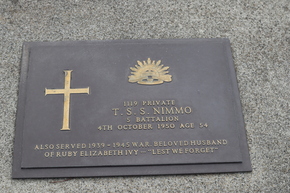NIMMO, Thomas Smith Shearer
| Service Number: | 1167 |
|---|---|
| Enlisted: | 3 October 1914 |
| Last Rank: | Private |
| Last Unit: | 5th Infantry Battalion |
| Born: | Woodend, Linlithgowshire, Scotland, date not yet discovered |
| Home Town: | Nalangil, Corangamite, Victoria |
| Schooling: | Not yet discovered |
| Occupation: | Farmer |
| Memorials: | Colac Nalangil Presbyterian Church Great War Honour Roll |
World War 1 Service
| 3 Oct 1914: | Enlisted AIF WW1, Private, 1167, 5th Infantry Battalion | |
|---|---|---|
| 22 Dec 1914: | Involvement Private, 1167, 5th Infantry Battalion, --- :embarkation_roll: roll_number: '8' embarkation_place: Melbourne embarkation_ship: HMAT Themistocles embarkation_ship_number: A32 public_note: '' | |
| 22 Dec 1914: | Embarked Private, 1167, 5th Infantry Battalion, HMAT Themistocles, Melbourne |
Help us honour Thomas Smith Shearer Nimmo's service by contributing information, stories, and images so that they can be preserved for future generations.
Add my storyBiography contributed by Stephen Brooks
An excerpt from the Colac Reformer 7 December 1915.
A SOLDIER'S LUCK. BAYONET AND EXPLOSIVE BULLET.
Private T. Nimmo, who was in employment in the Nalangil district for several years prior to enlisting, gives an account of his painful experiences at Gallipoli;
‘No doubt you would see my name in the list of wounded— fortunately not in the killed. I suppose you have heard what the landing at the Dardanelles was like. The first day was a complete hell. We got cut to pieces— not with cold steel, but with machine guns. Hundreds died at my feet. Oh, I was lucky! But not too lucky. I did not last very long, as I 'stopped one' on Sunday night. I was going pretty strong, from 6 a.m. till midnight, when the Turks charged to drive us into the sea. They turned on a terrible rain of fire, so we advanced to meet them. They came down in thousands, and we went for them.
I got a bayonet wound about three or four inches from the heart. I didn’t mind that so much and went on till I got an explosive bullet straight through both bones of the forearm. It was the left arm, fortunately. The arm was smashed to pieces and later septic poisoning appeared. When I got my wound in the arm I fell like a stone. The first thing I did was to grip my left wrist and hold it up on my chest. Then I crept back to get medical treatment, which was about a mile and a half away. The doctor dressed my arm, using my entrenching tool handle for a splint. Eventually I was placed on board a hospital ship. Just as we were getting on board, I lost consciousness and can remember nothing from that time till I woke up in hospital at Alexandria. From there they sent me on to England.’
Private Nimmo's bullet fractured forearm occured at the Landing on 25 April 1915. After treatment in England he was returned to Australia medically unfit 21 March 1916.









